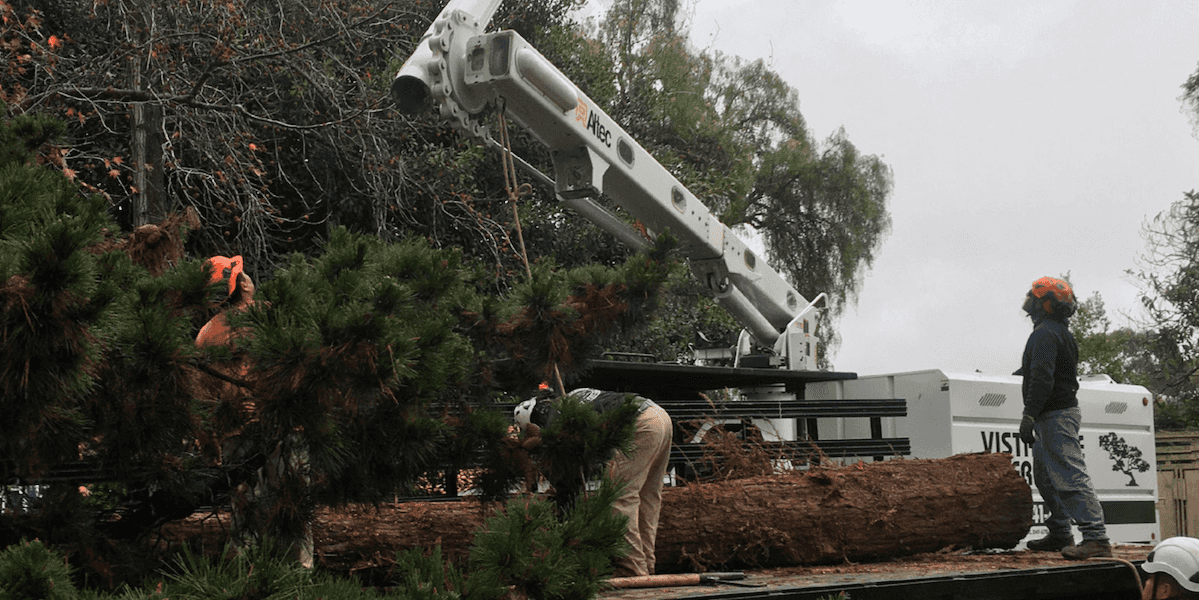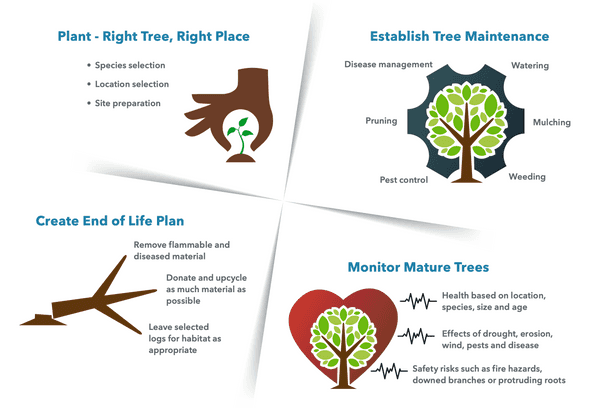Upcycle Urban Wood

End-of-life urban wood in the San Diego region is mostly wasted, meaning not put to its best use. When allowed to disintegrate, it releases large amounts of greenhouse gas (GhG) back into the atmosphere with little or no benefits to the community. The waste consists of entire dead and dying trees as well as trimmed and fallen branches.
Wasted urban tree material is costly to both our communities and the environment in which we live. Relatively few people and organizations understand this large waste stream’s negative impact and what they can do about it.
Turn Trash into Treasure
While there are over 40 uses for tree biomass, 4 make the most economic sense for the San Diego region:
- Lumber for building
- Wood pieces for furniture, decorative arts, handmade goods
- Biochar to conserve water and provide organic nutrients to the soil
- Fuel pellets that produce energy for localized use
Lack of public awareness about the pressure organic waste is putting on our overall landfill capacity, while municipalities are running out of landfill space, presents a serious challenge. The green/organic waste reduction targets established by California’s SB 1383 include a 50% reduction in the level of statewide disposal of organic waste from the 2014 level by 2020, and a 75% reduction by 2025. Many municipalities lack policies and plans to achieve these targets.
There is also insufficient awareness of what it takes to have a resilient urban forest. The Life Cycle diagram shows all the elements, including selection, placement, maintenance, and end-of-life tree material, most importantly wood.
Benefits of Upcycling Urban Wood
- Avoid taking up valuable landfill space
- Avoid the cost/tipping fees for adding tree biomass into landfills
- Meet the waste reduction mandates required by SB1383
- Avoid methane gas production,
- Continue to capture the wood’s carbon so it does not add to the greenhouse gas in our atmosphere
- Create green jobs
- Build new local businesses and grow existing ones
- Create useful products
- Fire prevention
- Avoid cost of transporting wood from outside the region and associated GhG emissions
- Avoid inadvertent transmission of tree diseases
- Create localized energy sources
- Conserve water
- Build healthier soils
Life Cycle of a Resilient Urban Forest

Help Increase Upcycling of Urban Trees
Currently only a modest local circular economy exists for our local tree material products. Consequently most of our end-of-life wood supply is not adequately upcycled. A thriving circular economy requires active participation by individuals as well as public and private organizations.
Supplier
Contribute your end-of-life tree material, either as an organization or an individual property owner. Contact Lumbercycle at (619) 321-8784 or lumbercycle@gmail.com. They will help you find a tree service who will channel the supply to the appropriate producers, e.g., sawmills, biochar producers, pellet producers, woodworkers. Usually there is no extra cost to doing this because tree services avoid paying landfill tipping (dumping) fees. However, sometimes there is extra cost depending on the situation so inquire about cost at the time.
Processor/Producer
Introduction for establishing an Urban Wood Use Program
Municipality
An information sheet from the California Urban Forests Council explains the benefits to municipalities of upcycling their tree waste. Municipalities can participate both as suppliers and customers.
Customer
Participate as a customer by purchasing products made from urban trees. This is very important because customer demand drives increases in production, thereby increasing upcycling of this material for:
- Lumber produced from local urban wood
- Products of woodworking
- Biochar
- Fuel pellets
Every part of a tree’s life is a community event.
— Tom Hamilton, CEO at LumberCycle
Best Practices
A bulletin from the Arbor Day Foundation explains the need to re-use urban tree material and describes success stories.
Frequently Asked Questions
What happens now to most of our region’s urban end-of-life wood?
Unfortunately, most of it is not upcycled to its best use. Instead the majority goes into landfills or is chipped and used as mulch or groundcover, which disintegrates fairly rapidly. While sometimes turning it into mulch is an appropriate use, many times it is not.
What is the role of trees in carbon sequestration?
The wood in trees contains a high percentage of carbon. Trees obtain carbon from CO2 molecules they absorb from the atmosphere during the photosynthesis process. This is why trees are considered “carbon sinks”. The amount of carbon stored in a given tree is a function of how much wood it has and its species. Some species store much more carbon than others.
What happens to the sequestered carbon when the wood is no longer living, either as detached branches or as end-of-life trees?
If the wood is left to disintegrate, the carbon molecules escape back into the atmosphere as CO2, the major contributor to Greenhouse Gas (GhG) and global warming. If allowed to disintegrate in a landfill, much of it turns into methane gas (CH4) which heats the atmosphere a lot more than even CO2.
What parts of the tree are most valuable for upcycling?
Generally wood is the most valuable, particularly the trunk and large branches. The wood is where most of the carbon is stored plus it has the most high-value uses. However, there are also uses for smaller twigs and leaves.
Is there anything wrong with chipping my trees and branches on-site to use as mulch?
Occasionally this is a proper use of your trees, especially on your own property, keeping the material in place. However, often the chipped material is not the appropriate quality of mulch because the particular tree species contains chemicals detrimental to the soil and the plants growing in it. Chipping high quality wood that could be made into fine furniture, household goods, decorative art and high quality lumber is a poor decision.
Are there tree species that cannot be turned into these four types of products?
Almost all can but unfortunately there are exceptions. For example, almost all palms cannot be upcycled, plus simply disposing of them creates an excessive carbon footprint because of the fibrous nature of their trunks and fronds. That is one of the reasons they are a poor choice to plant here for a resilient eco-system.
If a tree has been infected with disease, can its material be upcycled?
For the most part yes, but it depends on the disease. Also professional treatment may need to be applied regardless of what is done with the biomass to avoid transporting the disease to other locations or transmitting it within your immediate location.
Is using local wood for firewood a good idea?
Only under limited circumstances. Burning it returns all its sequestered carbon back into the atmosphere in the form of GhG. It is an inefficient fuel source for heating. Also moving diseased firewood from one location to another is a common cause of transmitting tree diseases to uninfected areas. Occasionally burning it in place for recreational or social purposes is acceptable, depending on local regulations.
Do tree growers and harvesters see the upcycled urban tree market as competition?
Urban trees represent a relatively small segment of the overall forestry products business and therefore are not seen as much direct competition. Wilderness forestry works at much larger scale and has many more options, including for planting and owning large swaths of trees to produce a much larger range of products. Generally the suppliers, producers, and customers for urban tree biomass are quite different than those for wilderness trees. The latter circular economy has been well-developed over centuries and has different issues and challenges from urban forestry. However, numerically there still are millions of urban trees, and most of their material is not being upcycled.